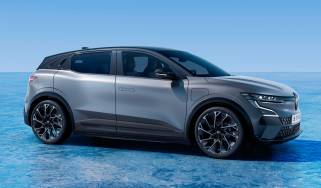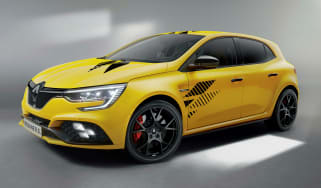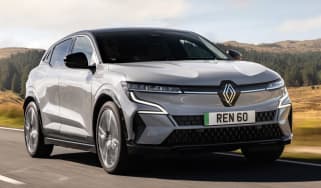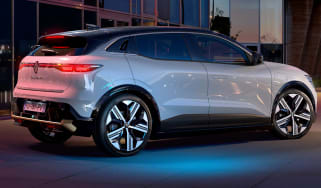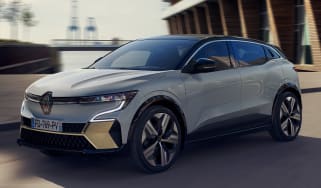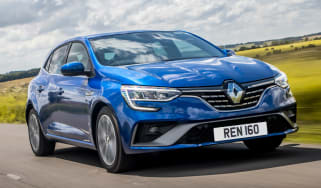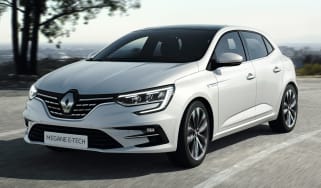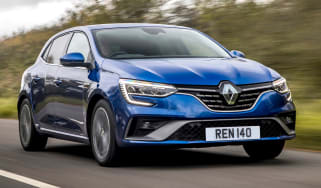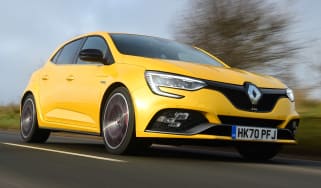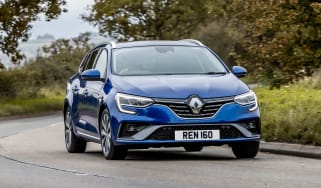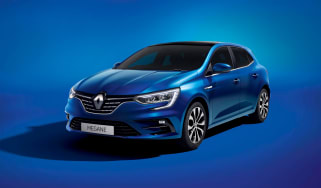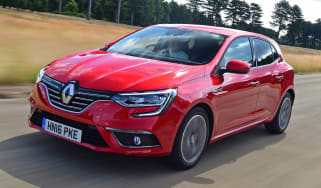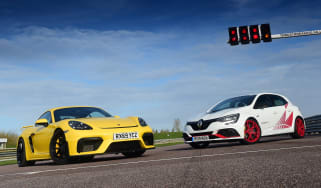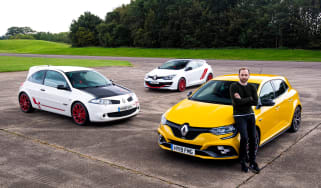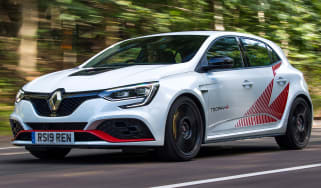Renault Megane E-Tech review
The latest Renault Megane E-Tech blends an old name with new tech for an EV-only future

Our opinion on the Renault Megane E-Tech
While the Renault Megane E-Tech isn't the freshest model in the company’s electric-car line-up, it’s still a very strong contender in the electric family hatchback class: it just goes to demonstrate that the French firm is on a roll with its EVs. The Megane E-Tech is appealing because of its style, especially inside, where the cabin manages to combine a modern layout with user-friendly technology.
It’s not the biggest EV on the market, so back-seat space isn’t much to write home about, and the ride is on the firm side, but if you can live with these shortcomings, then the car makes a lot of sense.
| Key specs | |
| Fuel type | Electric |
| Body style | Five-door, five seat hatchback |
| Powertrain | 60kWh battery, 1x electric motor, front-wheel drive |
| Safety | Five-star Euro NCAP (2022) |
| Warranty | Four years/100,000 miles |
About the Renault Megane E-Tech
While some brands have created all-new models for the electric era, and others have simply stopped making internal combustion-powered cars altogether, the Renault Megane E-Tech demonstrates the French firm’s practical choice of adapting household nameplates to become fully fledged EVs.
Allow for the bit of licence in adding E-Tech to the name, and that’s what has happened to the Megane. Moving into its fifth generation since the 1995 original, it has now fully turned its back on petrol and diesel power.
Its arrival in 2022 also marked a new era for the French firm and its electric car line-up. Until then, its EVs used running gear that was shared with combustion-engined models, but the Megane E-Tech marked the arrival of Renault’s CMF-EV platform (now called AmpR).
The Megane has always offered distinctive design (remember the big-booted Mk2?), and this latest car takes a dramatic turn again, with a sleek, rakish five-door hatchback shape and almost cartoonishly large 20-inch alloy wheels in higher trim levels. In a class that’s filled with compelling alternatives, it gives the Megane E-Tech a unique selling point.
Used - available now

2022 Renault
Megane E-Tech
15,989 milesAutomaticElectric
Cash £18,600
2022 Renault
Megane E-Tech
26,162 milesAutomaticElectric
Cash £18,204
2022 Renault
Megane E-Tech
17,383 milesAutomaticElectric
Cash £19,371
2022 Renault
Megane E-Tech
17,595 milesAutomaticElectric
Cash £20,490In terms of where it fits in the Renault line-up, the Megane E-Tech slots between the compact Renault 5 and Renault 4 electric models and the larger Renault Scenic, and its five-door hatchback body has family car buyers in mind. Unlike some rivals, there’s just one powertrain available, which features a 60kWh battery that powers an electric motor driving the front wheels.
The previous trim line-up of Evolution, Techno and Iconic versions has been updated to Techno, Techno Esprit Alpine, and Iconic Esprit Alpine, matching the trim line-up of other models in the manufacturer's range like the Renault Austral. There's a £4,500 difference between the highest and lowest specs, with prices starting lower than before, at around £32,500.
We don't see much point in going beyond the entry-level Techno model, which comes with more equipment than the previous Evolution trim. You get 18-inch alloy wheels, a large 12-inch portrait layout infotainment system with Google built in, wireless phone charging and smartphone connectivity, heated front seats and steering wheel, front and rear parking sensors, plus a reversing camera. You also get a more energy-efficient heat pump as standard, which helps to heat the interior in cold weather without using too much of your battery power, helping to preserve the available driving range.
Further up the range is the Techno Esprit Alpine with larger 20-inch wheels, adaptive cruise control, electric front seat adjustments, and sportier interior and exterior styling. The top-of-the-range Iconic Espirit Alpine comes with a 360-degree camera system, a smart view rearview mirror camera, and an upgraded Harman Kardon sound system.
Unlike the old petrol models, there’s no Renaultsport Megane, and there is unlikely to be one in the future, because the sporting brand Alpine is now used for Renault’s performance models. There are no plans to produce an Alpine Megane E-Tech to go alongside the Alpine A290, which is a more sporting version of the 5.
Performance & driving experience
| Pros | Cons |
|
|
Renault has kept things very simple with the Megane E-Tech’s line-up, because there’s a single motor and battery combination throughout the range. While some buyers might be disappointed that there isn’t a more potent version available, in reality, the powertrain is more than adequate for a family hatchback.
There’s a single motor driving the front wheels, and it produces a healthy 217bhp and 300Nm of torque. On the road, the Megane E-Tech feels as lively as the claimed numbers suggest. The throttle responds keenly to inputs, with the car jumping forward with real enthusiasm from a standstill. Those who find it too sharp can switch to Eco mode; this doesn’t blunt the overall performance, but does make the pedal a little less responsive at the top of its travel.
Electric motors, 0-60mph acceleration and top speed
At 1,685kg, the Megane E-Tech undercuts some of its competitors on weight by a significant margin – this is aided by the use of aluminium in external panels such as the doors – and this means that on-paper, straight-line speed is impressive. Officially, 0-62mph takes 7.5 seconds; to show the rate of progress in the automotive world, that puts it only a few tenths behind the iconic Renaultsport Clio 172 and 182 hot hatchbacks.
One area where the limitations of EVs are exposed is with their top speeds. While high-performance EVs can boast maximums of 200mph and beyond, the Megane E-Tech has an electronically limited maximum of 99mph to help preserve battery capacity. Obviously, that’s still more than enough for UK roads.
Town driving, visibility and parking
Very light and direct steering makes the Megane E-Tech easy to drive in tight spots, while EV owners who like to make full use of regenerative braking will enjoy the varying levels of deceleration on offer here. Those who favour one-pedal driving now have this option, whereas previous versions of Megane E-Tech only brought things down to a creep rather than a full stop.
A variety of artificial sounds can be chosen to warn pedestrians of your presence, including a slightly spooky tone created by French electronic music icon Jean-Michel Jarre. More jarring is the Megane E-Tech’s ride, because the mix of firm suspension and large 20-inch alloy wheels makes it a little harsher than we’d like from a family car.
B-road driving and handling
While that firmness makes the Megane E-Tech keen and capable through corners, there are two things holding it back from being an entertaining driver’s car. The first is the light steering, which doesn’t offer much feedback. That means placing the car on the road is done more through guesswork and muscle memory than delicacy and feel.
Then there’s the stability control system, which is very restrictive and caps the power until the wheel is almost completely straight. This makes it hard to flow smoothly along a twisty road. These things are a shame, because the Megane E-Tech feels like it has a promising chassis that’s only hamstrung by software.
Motorway driving and long-distance comfort
We have no issues with the Megane E-Tech’s high-speed stability – its low centre of gravity makes it feel very planted at speed – but that firm ride can still be felt. With a slightly softer set-up, it could be a very relaxing motorway companion, because the electric motor still has plenty of performance to give and wind noise is fairly well suppressed.
Expert view, on driving experience
“Manufacturers are continuously refining and improving their EV tech with each new model, and this is obvious when the Megane E-Tech’s brakes are compared with the newer Renault 5. Where the 5 offers a firm, reassuring pedal that transitions fairly smoothly between motor regen and mechanical braking, the Megane E-Tech’s feels very light yet sharp and is hard to modulate.” - Alex Ingram, chief reviewer, who tested the Megane E-Tech in the UK against the Skoda Elroq
| Model | Power | 0-62mph | Top speed |
| Megane E-Tech EV60 | 217bhp | 7.5 seconds | 99mph |
Range, charging & running costs
| Pros | Cons |
|
|
Electric range, battery life and charge time
When we tested the Megane E-Tech against the Skoda Elroq, we covered a wide mix of driving, including lots of motorway mileage – something that isn’t very flattering for the efficiency of most EVs. With this in mind, plus the cool temperatures of the time of year we did the test, we were disappointed to average only 3.8 miles/kWh, barely beating the larger Elroq, which managed 3.7mi/kWh in similar conditions. That efficiency figure translates into a real-world range of 228 miles, which will be fine for urban driving, but might not be suitable for regular long-distance motorway users.
The Megane E-Tech can charge at up to 130kW, which means a 15-80 per cent top-up can take as little as 32 minutes. It’s worthwhile plotting a route to a charging station if you intend to use one, because this will allow the Megane E-Tech to pre-condition the battery so it’s at the optimum temperature to take a higher rate of charge when you plug in to a charging station. Without this function, the rate of charging will be much slower, particularly in cold temperatures.
Unfortunately, the pre-conditioning feature doesn’t work if you’re navigating through a mapping app on either Apple CarPlay or Android Auto. Rivals from the Volkswagen Group allow the driver to manually precondition the battery, which would be a useful feature to add here, too.
| Model | Battery size | Range | Insurance group |
| Megane E-Tech EV60 Evolution | 60kWh | 285 miles | 26 |
| Megane E-Tech EV60 Iconic | 60kWh | 281 miles | 26 |
Insurance groups
Premiums for the Megane E-Tech should be reasonable, because all models sit in either group 25 or 27 out of 50. In comparison, the MG4 Long Range is in group 28 or 29, while the Cupra Born falls into groups 25 to 28, depending on which trim level you opt for. If you’re interested in paying even less for insurance, then consider the electric Citroen e-C4, which starts in insurance group 21.
Tax
An electric car will bring tax benefits compared with an equivalent petrol, diesel or hybrid model. That’s because an EV’s lower emissions mean company-car drivers will pay far less in Benefit-in-Kind (BiK) tax. The Megane E-Tech sits in the three per cent BiK band, while the Megane E-Tech’s P11D values are competitive with rival EVs.
Unfortunately, electric cars no longer enjoy free Vehicle Excise Duty (VED) road tax, but at least no model in the Megane E-Tech range costs more than the £40,000 luxury car tax threshold, so you only have to pay the standard VED rate.
Depreciation
With estimated residual values of 43-45 per cent, the Megane E-Tech falls slightly short of the class average when it comes to depreciation. Its figures are slightly better than the MG4’s (41-44 per cent), but a little behind the Kia EV3 (45-48 per cent).
Interior, design & technology
| Pros | Cons |
|
|
Fantastic interior design and a class-leading infotainment system give the Megane E-Tech one of the best cabins in the segment.
Interior and dashboard design
From the slightly square-shaped steering wheel to the use of fabrics on the dashboard and even a woven material on the headlining, the Megane E-Tech’s cabin looks contemporary and feels expensive.
More importantly, the ergonomics are well considered, too. A small row of toggle switches just below the touchscreen operates the air-conditioning system, while those who wish to personalise the various driver-assist systems to their liking are treated to one of the easiest set-ups in the business.
Materials and build quality
The cabin quality feels sturdy enough, with a level of quality that you won’t find in rivals from MG or even Kia. There’s a little too much piano-black plastic on show, which could be prone to scratches. But that aside, the Megane E-Tech’s cabin looks expensive.
Infotainment, sat-nav and stereo
Driver-assist tech is a hot topic among new cars, with many mandatory systems proving to be a mild irritant or worse to many drivers, especially when their readings aren’t 100 per cent reliable. Renault makes switching between the systems easier than anyone else.
The My Perso button can be programmed exactly to your liking through the driver-assist page on the infotainment screen; once the likes of speed-limit warning and lane-keep assist settings have been chosen, they can be enabled or disabled by twice pressing a button to the right of the steering wheel.
As for the main touchscreen, Renault was among the first brands to completely embrace a Google operating system, and that transformed its infotainment tech from distinctly average to the best you’ll find from any car maker right now. Because Google is built in, it allows users to install more than 50 apps, including Waze, Spotify and Amazon Music, to personalise the system to their tastes. Speaking of music, audiophiles may want to upgrade to the top-of-the-range Iconic Espirit Alpine version in order to get the fancier 12-speaker Harman Kardon sound system.
Expert view, on design
“The touchscreen menus are easy to work out, while loading and response times on the built-in Google Maps are fantastic. Over-the-air updates can add further features in the future.” - Alex Ingram, chief reviewer, who tested the Megane E-Tech in the UK against the Skoda Elroq in a group test
Boot space & practicality
| Pros | Cons |
|
|
Dimensions and size
The Megane E-Tech introduced a radical look with its switch to electrification, but the overall dimensions are similar. The electric model is shorter and narrower, but it’s taller and has a longer wheelbase. Those measurements mean it’s similar in size to the Volkswagen ID.3, MG4 and Cupra Born.
| Dimensions | |
| Length | 4,200mm |
| Width | 1,768mm |
| Height | 1,505mm |
| Number of seats | Five |
| Boot space | 440-1,332 litres |
Driving position, seats & space in the front
A comfortable and highly adjustable seating position helps the driver feel at home quickly, but those looking for adjustable lumbar support and electric front seat adjustments will need to go for the mid-range Techno Esprit Alpine and above to get this. Doing so also adds a massage function for the driver's seat.
There's generous storage, including a neat high-level smartphone shelf, a decent-sized glovebox, and a huge open area beneath the dash. This would be a more useful place to put the USBs than the raised centre armrest, which is where Renault has located them. The door bins are quite deep, but also slim. An ISOFIX point on the front passenger seat complements two more in the back, improving flexibility as to how you can arrange things.
The rakish exterior means rear visibility is very poor. The back window is so slim it feels like peering through a letterbox, and because the C-pillar houses the high-level door handles, even more glass area that could otherwise have been used to improve the view out has been sacrificed.
Seats & space in the back
These characteristics mean that back-seat occupants will feel a little more claustrophobic than in some other family hatchbacks – it is quite dark in the rear.
Knee room is okay – about the same as in the Renault Captur small SUV – but the floor is too high relative to the seat base, which forces taller passengers to lift their legs away from the seat, limiting under-thigh support. Add a shortage of foot space beneath the front seats, and it can feel a little more cramped than in competitors. Only top-spec models get rear USB ports, and there’s no rear centre armrest.
Boot space
Getting into the boot is the most annoying thing about the rear space. Rather than a hidden switch beside a number plate light as in so many rivals, the boot control is a tiny body-coloured button that sits flush with the boot lid. Its position means that it gets really dirty after driving on wet roads.
That aside, the 440-litre space is generous for a car of this size and beats rivals such as the MG4 (363 litres) and VW ID.3 (385 litres), while getting closer to models such as the Kia EV3 (460 litres) and Skoda Elroq (470 litres).
Expert view, on practicality
“EVs haven’t really embraced towing, but the Megane E-Tech is able to haul up to 900kg, which will be enough for a trailer, but a caravan might be a bit much for it.” - Alex Ingram, chief reviewer, who tested the Megane E-Tech in the UK against the Skoda Elroq in a group test
Reliability & safety
| Pros | Cons |
|
|
Euro NCAP awarded the Megane E-Tech a maximum five-star rating, with an 85 per cent score for adult occupant protection and 88 per cent for child passenger safety. The car’s driver-assist systems also performed well, receiving a 79 per cent rating, but the Megane E-Tech lost marks for pedestrian protection (65 per cent overall), and it was beaten in all areas by the higher scoring Cupra Born, which was also tested in 2022.
The Renault brand finished a lowly 28th out of 32 brands in our 2024 Driver Power owner satisfaction survey, with owners praising running costs and the amount of boot space offered, but finding issues with front seat comfort and visibility from the driver's seat.
| Key standard safety features | Euro NCAP safety ratings |
|
|
Buying and owning
- Best buy: Renault Megane E-Tech Techno
The entry-level Techno gets a full suite of electronic safety systems, and you can easily pick and choose which of these systems you want working in the background as you drive via the My Perso button.
The Megane E-Tech comes with a four-year/100,000-mile warranty. In comparison, the Skoda Elroq is covered by a three-year/60,000-mile package, but Hyundai, Kia and MG have longer terms for their warranty coverage. As with many EVs, the Renault’s battery has a separate eight-year/100,000-mile warranty.
Renault’s EasyLife service plan lets buyers spread the cost of scheduled maintenance. They have a choice of a three or four-year agreement, each running to 48,000 miles, with the four-year deal also covering the first MoT. For an extra £1 a month, the latter pack can add an extra year of warranty cover, too.
Alternatives
There are a number of VW Group rivals to take on the Megane E-Tech, including the Volkswagen ID.3, Cupra Born and Skoda Elroq, the latter of which is a strong contender for its practicality and versatility. Elsewhere, the Hyundai Kona is a former Auto Express Car of the Year, while the Kia EV3 and Kia Niro EV are also worth shortlisting. More conventional hatchbacks such as the Peugeot E-308 and Vauxhall Astra Electric are also available.
Renault Megane E-Tech Techno long-term test
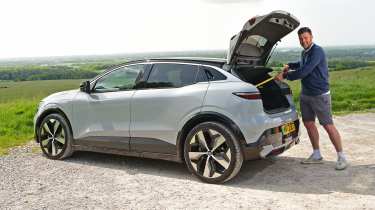
In the first six months of 2023, our group website editor, Steve Walker, ran a Renault Megane E-Tech Techno for a long-term test. Steve has two children, and the rear legroom of the Megane E-Tech proved to be tight for them on long journeys, especially behind his preferred driving position (he's just over 6ft tall).
He also found the cold weather range of the test car (which was not equipped with a heat pump at the time - it's now standard) was greatly reduced compared to the range in warmer conditions. On the plus side, the Megane E-Tech's interior quality and design stand out from the other cars in the class with a high-quality feel. The driving experience also impressed, the Megane E-Tech giving a great balance between comfort and responsive handling. You can read the full long term test here...
Renault Megane E-Tech pictures
Frequently Asked Questions
If you’re not fussed about back-seat space, then it could be all the EV you could need. It offers a decent range, neat in-car tech and a decent drive, if you can live with the firm ride.








